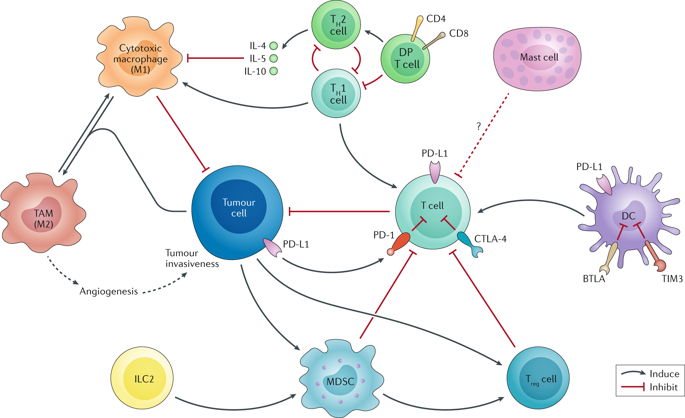当前位置:
X-MOL 学术
›
Nat. Rev. Urol.
›
论文详情
Our official English website, www.x-mol.net, welcomes your feedback! (Note: you will need to create a separate account there.)
The multifaceted immune regulation of bladder cancer.
Nature Reviews Urology ( IF 15.3 ) Pub Date : 2019-09-09 , DOI: 10.1038/s41585-019-0226-y Anna K Schneider 1 , Mathieu F Chevalier 1, 2, 3 , Laurent Derré 1
Nature Reviews Urology ( IF 15.3 ) Pub Date : 2019-09-09 , DOI: 10.1038/s41585-019-0226-y Anna K Schneider 1 , Mathieu F Chevalier 1, 2, 3 , Laurent Derré 1
Affiliation

|
Bladder cancer is an important public health concern owing to its prevalence, high recurrence risk and treatment failures. Maintaining the equilibrium between prompt and effective immunity and an excessive and protracted immune response is critical for successful immune defence. This delicate balance is ensured by intrinsic or extrinsic immunoregulatory mechanisms. Intrinsic control of immune cell activation is mediated by stimulatory and inhibitory receptors expressed on the effector cell itself, whereas extrinsic control is mediated via other immune cells by cell-cell contact and/or secretion of inhibitory factors. Tumours can exacerbate these immunosuppressive pathways, fostering a tolerant microenvironment. These mechanisms have previously been poorly described in urothelial carcinoma, but a growing body of evidence highlights the key role of immune regulation in bladder cancer. This process includes immune checkpoints (mostly programmed cell death 1 (PD-1) and programmed cell death 1 ligand 1 (PD-L1)), as well as regulatory T cells, myeloid-derived suppressor cells, tumour-associated macrophages and type 2 innate and adaptive lymphocytes. For each component, quantitative and qualitative alterations, clinical relevance and potential targeting strategies are currently being explored. An improved understanding of immune regulation pathways in bladder cancer development, recurrence and progression will help in the design of novel diagnostic and prognostic tools as well as treatments.
中文翻译:

膀胱癌的多方面免疫调节。
膀胱癌由于其患病率,高复发风险和治疗失败而成为重要的公共卫生问题。维持迅速有效的免疫力与过度和长期的免疫反应之间的平衡,对于成功的免疫防御至关重要。这种微妙的平衡是通过内在或外在的免疫调节机制来确保的。免疫细胞激活的内在控制是由效应细胞本身表达的刺激性受体和抑制性受体介导的,而外在性控制则是通过其他免疫细胞通过细胞间接触和/或抑制因子的分泌而介导的。肿瘤会加剧这些免疫抑制途径,从而促进耐受的微环境。这些机制先前在尿路上皮癌中的描述很差,但是越来越多的证据凸显了免疫调节在膀胱癌中的关键作用。此过程包括免疫检查点(主要是程序性细胞死亡1(PD-1)和程序性细胞死亡1配体1(PD-L1)),以及调节性T细胞,髓样来源的抑制细胞,肿瘤相关巨噬细胞和2型先天性和适应性淋巴细胞。对于每种成分,目前正在探索定量和定性的变化,临床相关性和潜在的靶向策略。对膀胱癌发展,复发和进展中免疫调节途径的深入了解将有助于设计新颖的诊断和预后工具以及治疗方法。此过程包括免疫检查点(主要是程序性细胞死亡1(PD-1)和程序性细胞死亡1配体1(PD-L1)),以及调节性T细胞,髓样来源的抑制细胞,肿瘤相关巨噬细胞和2型先天性和适应性淋巴细胞。对于每种成分,目前正在探索定量和定性的变化,临床相关性和潜在的靶向策略。对膀胱癌发展,复发和进展中免疫调节途径的深入了解将有助于设计新颖的诊断和预后工具以及治疗方法。此过程包括免疫检查点(主要是程序性细胞死亡1(PD-1)和程序性细胞死亡1配体1(PD-L1)),以及调节性T细胞,髓样来源的抑制细胞,肿瘤相关巨噬细胞和2型先天性和适应性淋巴细胞。对于每种成分,目前正在探索定量和定性的变化,临床相关性和潜在的靶向策略。对膀胱癌发展,复发和进展中免疫调节途径的深入了解将有助于设计新颖的诊断和预后工具以及治疗方法。目前正在探索临床相关性和潜在的靶向策略。对膀胱癌发展,复发和进展中免疫调节途径的深入了解将有助于设计新颖的诊断和预后工具以及治疗方法。目前正在探索临床相关性和潜在的靶向策略。对膀胱癌发展,复发和进展中免疫调节途径的深入了解将有助于设计新颖的诊断和预后工具以及治疗方法。
更新日期:2019-09-10
中文翻译:

膀胱癌的多方面免疫调节。
膀胱癌由于其患病率,高复发风险和治疗失败而成为重要的公共卫生问题。维持迅速有效的免疫力与过度和长期的免疫反应之间的平衡,对于成功的免疫防御至关重要。这种微妙的平衡是通过内在或外在的免疫调节机制来确保的。免疫细胞激活的内在控制是由效应细胞本身表达的刺激性受体和抑制性受体介导的,而外在性控制则是通过其他免疫细胞通过细胞间接触和/或抑制因子的分泌而介导的。肿瘤会加剧这些免疫抑制途径,从而促进耐受的微环境。这些机制先前在尿路上皮癌中的描述很差,但是越来越多的证据凸显了免疫调节在膀胱癌中的关键作用。此过程包括免疫检查点(主要是程序性细胞死亡1(PD-1)和程序性细胞死亡1配体1(PD-L1)),以及调节性T细胞,髓样来源的抑制细胞,肿瘤相关巨噬细胞和2型先天性和适应性淋巴细胞。对于每种成分,目前正在探索定量和定性的变化,临床相关性和潜在的靶向策略。对膀胱癌发展,复发和进展中免疫调节途径的深入了解将有助于设计新颖的诊断和预后工具以及治疗方法。此过程包括免疫检查点(主要是程序性细胞死亡1(PD-1)和程序性细胞死亡1配体1(PD-L1)),以及调节性T细胞,髓样来源的抑制细胞,肿瘤相关巨噬细胞和2型先天性和适应性淋巴细胞。对于每种成分,目前正在探索定量和定性的变化,临床相关性和潜在的靶向策略。对膀胱癌发展,复发和进展中免疫调节途径的深入了解将有助于设计新颖的诊断和预后工具以及治疗方法。此过程包括免疫检查点(主要是程序性细胞死亡1(PD-1)和程序性细胞死亡1配体1(PD-L1)),以及调节性T细胞,髓样来源的抑制细胞,肿瘤相关巨噬细胞和2型先天性和适应性淋巴细胞。对于每种成分,目前正在探索定量和定性的变化,临床相关性和潜在的靶向策略。对膀胱癌发展,复发和进展中免疫调节途径的深入了解将有助于设计新颖的诊断和预后工具以及治疗方法。目前正在探索临床相关性和潜在的靶向策略。对膀胱癌发展,复发和进展中免疫调节途径的深入了解将有助于设计新颖的诊断和预后工具以及治疗方法。目前正在探索临床相关性和潜在的靶向策略。对膀胱癌发展,复发和进展中免疫调节途径的深入了解将有助于设计新颖的诊断和预后工具以及治疗方法。


























 京公网安备 11010802027423号
京公网安备 11010802027423号